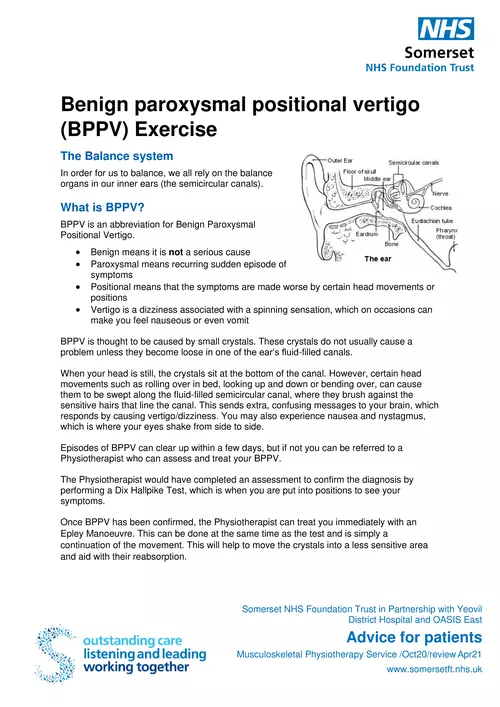
Benign paroxysmal positional vertigo (BPPV) - Somerset NHS
exercise-based therapy6 in treating posterior canal BPPV. However, even with successful treatment with such maneuvers, BPPV recurs in about one-.
adsPart of the document
Benign paroxysmal positional vertigo
(BPPV) Exercise
The Balance system
In order for us to balance, we all rely on the balance
organs in our inner ears (the semicircular canals).
What is BPPV?
BPPV is an abbreviation for Benign Paroxysmal
Positional Vertigo.
Benign means it is not a serious cause
Paroxysmal means recurring sudden episode of
symptoms
Positional means that the symptoms are made worse by certain head movements or
positions
Vertigo is a dizziness associated with a spinning sensation, which on occasions can
make you feel nauseous or even vomit
BPPV is thought to be caused by small crystals. These crystals do not usually cause a
problem unless they become loose in one -filled canals.
When your head is still, the crystals sit at the bottom of the canal. However, certain head
movements such as rolling over in bed, looking up and down or bending over, can cause
them to be swept along the fluid-filled semicircular canal, where they brush against the
sensitive hairs that line the canal. This sends extra, confusing messages to your brain, which
responds by causing vertigo/dizziness. You may also experience nausea and nystagmus,
which is where your eyes shake from side to side.
Episodes of BPPV can clear up within a few days, but if not you can be referred to a
Physiotherapist who can assess and treat your BPPV.
The Physiotherapist would have completed an assessment to confirm the diagnosis by
performing a Dix Hallpike Test, which is when you are put into positions to see your
symptoms.
Once BPPV has been confirmed, the Physiotherapist can treat you immediately with an
Epley Manoeuvre. This can be done at the same time as the test and is simply a
continuation of the movement. This will help to move the crystals into a less sensitive area
and aid with their reabsorption.


